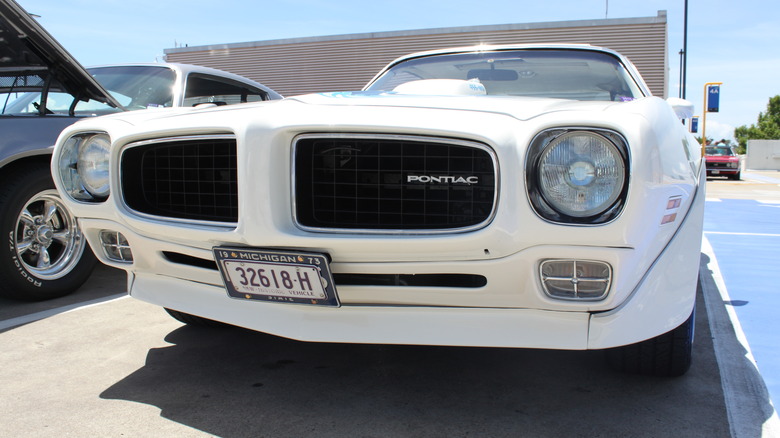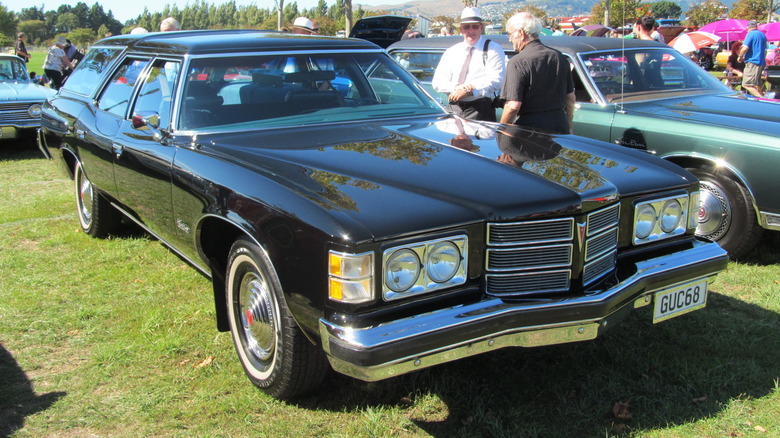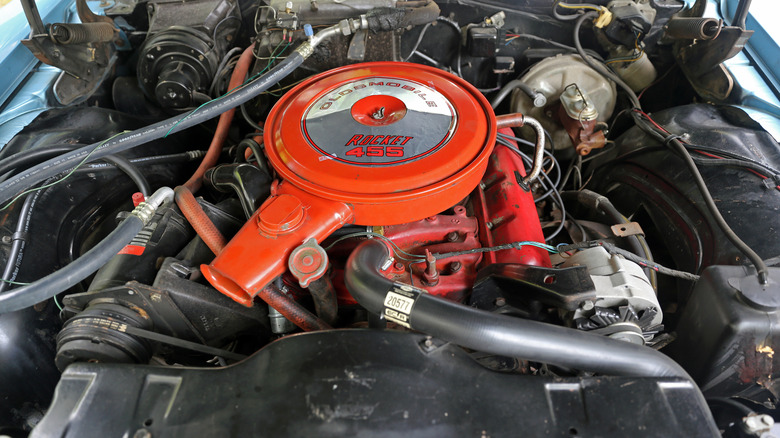Oldsmobile 455 Vs Pontiac 455: What's The Difference?
The golden age of the muscle car ended in the mid-1970s after the 1973 oil crisis and emissions restrictions were put into effect. No longer could these smaller sports cars be packed with these gigantic V8 engines to give them a ridiculous amount of power. Due to being from a bygone era, the engines from that time have become something of a legend to gearheads with a particular rose-colored affinity for that in-your-face power of American automobiles from the era.
Many different automobile companies created their own hulking V8 engines; sometimes, one manufacturer would develop several different engines of the same size for different brands. For instance, General Motors once owned both Pontiac and Oldsmobile, and each company had its own distinct 455 V8 engine. You might think that GM would want to standardize across all its brands as a cost-saving measure or to make production a little more seamless, but that wasn't the case.
While the two 455 V8 engines had similarities and a comparable amount of time in production, GM let its two brands tailor these massive engines to what they needed for each company's line of muscle cars.
[Featured image by Jeremy via Wikimedia Commons | Cropped and scaled | CC BY 2.0]
The Pontiac 455
Pontiac was no stranger to V8 engines prior to the 455. The company had been producing them since the mid-1950s, and as the years progressed, those V8s continued to grow with popular engines like the Pontiac 389. The replacement for that engine, the Pontiac 400, had a short but decent run for a couple of years before it and the 428 were effectively replaced by the 455 V8 in 1970.
The 455 was created by boring out the Pontiac 421 Super Duty engine. The Super Duty was an engine mostly used for racing purposes, but Pontiac looked to use this new 455, which now had a bore of 4.1525 inches with a 4.21-inch stroke. This new engine topped out at around 370 horsepower, which may not have been the most powerful engine at the time, but it could also produce 500 lb-ft of torque, which is rather beastly.
Pontiac would use this 455 engine in a good number of their vehicles, from high-performance GTO cars to full-size sedans, and over the next few years, the company would also produce Super Duty and High Output versions of the 455. As was often the case with these muscle car V8 engines, the initial horsepower results were impressive, but the maximum horsepower would gradually decline with each new model year. The emissions restrictions certainly wouldn't help that in the long run, and by the end of 1976, the Pontiac 455 had its final day in the sun.
[Featured image by Riley via Wikimedia Commons | Cropped and scaled | CC BY 2.0]
The Oldsmobile 455 Rocket
The Oldsmobile 455 V8 made its way to the public a couple of years before the Pontiac 455. Nicknamed the Rocket 455, this engine was the next step in Oldsmobile's big block line of V8s, a delineation in engine sizes that most General Motors companies made except for Pontiac. With its 4.126-inch bore and 4.25-inch stroke, its size was actually larger than a 455. In terms of what the engine could generate, it could reach a maximum of 400 hp and, like the Pontiac 455, 500 lb-ft of torque.
The range of cars in which the Rocket 455 was utilized was extremely wide. Yes, it was put under the hoods of Oldsmobile muscle cars, but if you wanted it in a larger, full-size vehicle, that was also an option. Even a luxury car like the Oldsmobile Toronado could support the Rocket 455, though that only lasted a short number of years.
Like the Pontiac 455, the Rocket 455 would quickly lose its luster, as horsepower and torque would dwindle as the years passed. For its last few years, the Rocket 455 was essentially relegated to use in station wagons like the Oldsmobile Vista Cruiser and the GMC Motorhome. The Oldsmobile Rocket 455 V8 engine met the same exact fate as the Pontiac 455, leaving the marketplace by the end of 1976. When efficiency became a top priority, these massive 455 V8 engines just had no place anymore.
[Featured image by Mr.choppers via Wikimedia Commons | Cropped and scaled | CC BY-SA 3.0]


